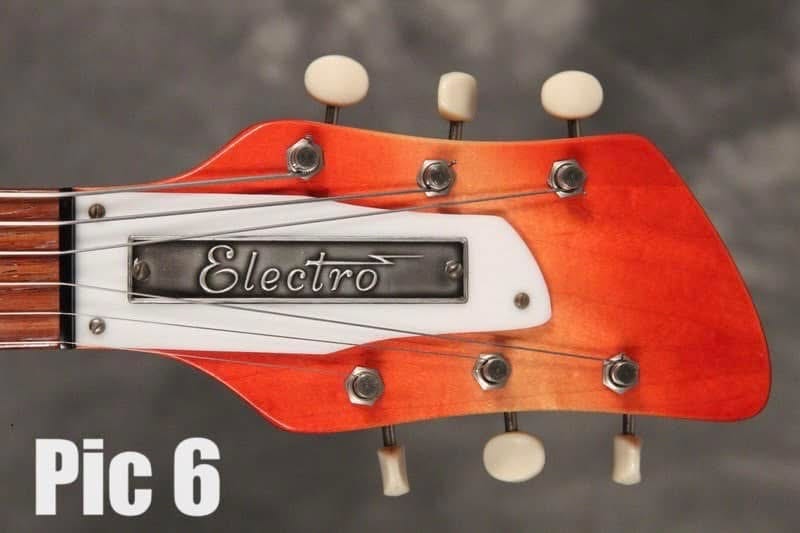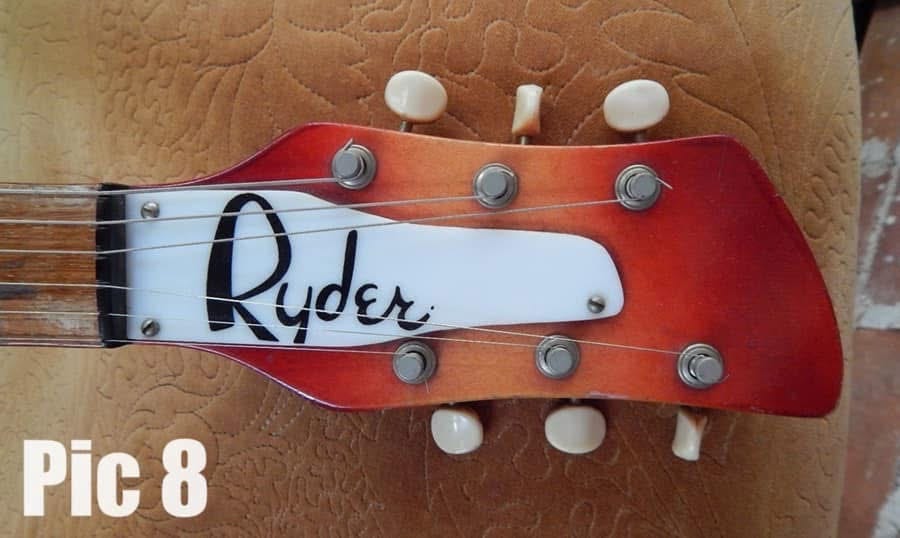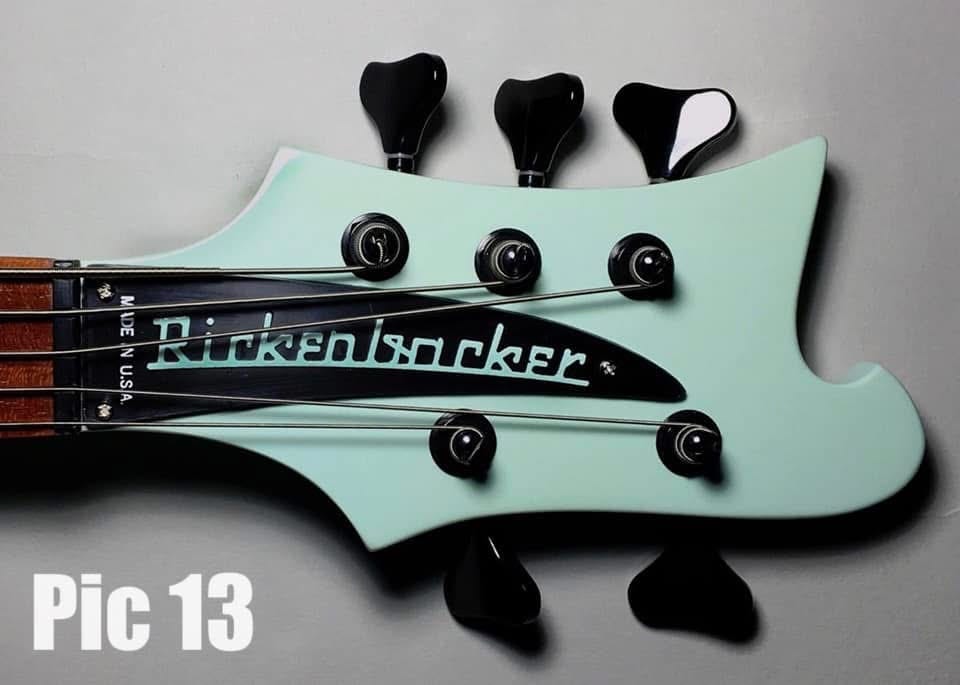Special Truss Rod Covers
So let’s quickly define “standard” versus “special” truss rod covers. “Standard” means…well, what you would find on a stock “catalog” guitar, era by era. You can find a rundown of them HERE. “Special” absolutely still means factory installed, but found ONLY on an…unusual or limited production instrument. I have four major categories of these that we’ll go into here:
Vaguely-guitar-like-instruments-that-aren’t-actually-guitars
Private label guitars
Signature Edition
Special runs/One-Offs
We’ll describe each one in more detail as we get into it. Ready? Let’s go!
We’ll start with vaguely-guitar-like-instruments-that-aren’t-actually-guitars. What do I mean by that? Three instruments spring to mind: the Bantar, the Banjoline, and the Mando Guitar. Two of them had unique TRCs. The odd man out was the Bantar (officially model 6000), which wore the era correct black letters/parallel MADE IN U.S.A. white plexi TRC—albeit shaved down a bit to fit the narrower nut.
But the Banjoline got its own thang. A six string instrument that was strung with two pairs of two strings (like a mandolin) and two single strings, it came in two flavors—the “standard” 6005 with a 360-ish round top and bound dot neck and the “deluxe” 6006 with a 381-ish carved top and triangle inlays (and checkered bound headstock!)—and they both shared unique truss rod cover. The back painted white plexi TRC featured a black Rickenbacker logo with MADE IN THE USA perpendicular to the logo, and parallel to the logo and “Banjoline (in brushscript font) Created by EDDIE PEABODY” below and parallel to the logo (Pic 1). At least one instrument appears on the register with a “stock” perpendicular MADE IN U.S.A. white plexi TRC, but all other photos I’ve seen have the unique Banjoline TRC. This instrument was made from 1968 to 1969.

The other guitar shaped object is the Mando Guitar. You could make the case that this belongs in the private label guitar category, but…it’s not a guitar so I put it here. So there! So what do we know about the Mando Guitar? It’s effectively a mandolin with a 24 ½” scale, with four pairs of two strings, tuned in fifths an octave lower than a standard mandolin. Similar to the 6005 Banjoline it has a 360-ish round top and a bound dot neck. There were (as best as we can tell) only two custom made in 1971, and the white plexi TRC does NOT bear the Rickenbacker logo, but instead says “Mando Guitar” with “by FERRARA” underneath and parallel (Pic 2). A quick google search tells us that a Richard J. Ferrara filed a patent in 1966 for an 8 string guitar shaped instrument tuned in fifths, so it’s not much of a leap to guess who “by FERRARA” is.

Next we move into the category of private label guitars. These are entry level instruments produced by Rickenbacker using stock or slightly-modified models (the 1000 and 425, to be precise) to be sold through music schools for students, usually paired with an amplifier. Electro was Rickenbacker’s in-house brand for schools that didn’t want to commission a “special run”, and Ryder, Contello, and Symfonia Grand were made for specific schools. Each had their own unique truss rod cover. Let’s talk about them!
The Contello and Symfonia Grand models were the first private label guitars made by Rickenbacker, for the Milton Mann Studios music school chain. A significantly modified 425, an order was placed for 50 guitars in 1962. The first 12 were made bearing the Contello name, and the remainder were branded Symfonia Grand. That’s the only difference between the two. The truss rod cover shape is unique, but not hugely dissimilar to the stamped metal TRC that had just been phased out on the donor 425. Like the stock Rickenbacker TRC of the time, it was back-painted white plexiglass with either “Contello” (Pic 3) or “Symfonia Grand” (Pic 4) silk screened on the back.


Already using the old Electro brand for student lap steel and amplifier packages and sensing a market for guitars, Rickenbacker added them into the mix in 1963 offering thusly rebranded 1000s and 425s which would wear three truss rod covers over their lifespan. The very first Electro truss rod cover was very much a case of “what can we throw together quickly?” They took the standard Rickenbacker plexi TRC, back-painted it white without any lettering, and screwed a stamped metal “Electro” name plate (as used on Electro lap-steels and amps) to it (Pic 5). This cover appears on some guitars made in 1963 and 1964.

Except for those that got…
The second Electro truss rod cover was a kind of “in-between” solution. The shape is NOT the standard Rickenbacker crescent—instead it’s kind of a…blob? I dunno, look at Pic 6 below. We will see this shape again when we talk about Ryders. It’s also not back painted plexiglass like all other TRCs were at this point; instead it is made of the same Perspex material as used on pickguards. But it has the same stamped metal Electro name plate screwed to it like the first version. This truss rod cover also appears on guitars made 1963 and 1964.

The third and final Electro truss rod cover appeared in early 1965. This one was a different, longer white blob, but this time in back-painted plexi with the “Electro” logo silkscreened on the back (Pic7). Electro models would be made in fits and starts between then and 1972, with a final batch made to use up leftover bodies in 1983.

Ryders were made between 1963 and 1966 for the Ryder Music School. They used the Perspex blob shape we saw above on the second Electro truss rod cover—although it evolved some over time—but had a stylized Ryder logo silk screened in black on top (Pic 8 ).

And with that, we have finished our chapter on private label guitars! So on to…
Signature Editions. I know what you’re thinking: “since most Signature Editions are an homage to a particular guitar played by a particular artist at a particular time, shouldn’t they wear a era appropriate truss rod cover?” To which I say, “100% correct, and most do—or at least they use the ‘reissue’ TRC that was on the shelf at the time it was made.” But what about guitars that are their own thing? A BRAND NEW signature model that never existed before? In the case of John Kay, Al Cisneros and Suzanna Hoffs, they just used what was on the shelf at the time. But not Glenn Frey. Glenn got his own thing.
The Glenn Frey 230 and 2030 wore a silver back-painted plexi truss rod cover, with a parallel MADE IN U.S.A. (Pic 9). The only guitar to ever wear a silver back-painted TRC. And given how few were made, if you break yours you are SOL. Luckily, nobody wants one, so it’s pretty easy to just replace the whole guitar! These guitars were made from 1992 to 2000.

And now we come to the biggest category: special runs/one-offs. Some special runs are dealer specific—think of all the Andy Babiuk runs we’ve seen over the years—some are available for whatever dealer wants them. They could be made to commemorate something special, like the 75th Anniversary specials, or they could be made cause John or Ben was bored and wanted to make something cool. I KNOW I’m gonna miss some here, so please let me know and I’ll add. Let’s go!
To commemorate Rickenbacker’s 75th anniversary, 75 each 660s, 330s, 360s, and 4003s were made over 2006-2007 with a Dark Metallic Cherry finish and a gold plexi truss rod cover with silver logo and parallel MADE IN U.S.A. (Pic 10).

A 2014 special run of 620s and 4003s in both Ruby and Pearl Jetglo was made for the Japanese market in 2014 wearing mirrored back truss rod covers with an etched outline logo, etched perpendicular MADE IN U.S.A., and an etched “registered trademark” R inside a circle below that (not sure if that’s really what it is—maybe it means something else in Japan?) (Pic 11). It also appeared on a one-off 480 in Pearl White in 2015. It went on to appear on a 2017 run of Jetglo Pearlstar 4003s (subsequent Jetglo Pearlstar runs have worn a gold plexi TRC).

The 2016 4003 and 360CB Noir runs in 2016 introduced a black plastic truss rod cover with engraved white outline logo and perpendicular MADE IN U.S.A. (Pic 12). A second 4003 Noir run in 2017 also used this TRC. It also appeared on several one-offs, including a 2018 620 with a maple fretboard in Satin Black, a 2018 4003 in Fireglo with Richlite fingerboard, a 2019 360 in blueburst, and two 4030s made in 2018 and 2019. 2019 seems to be the last year for this particular TRC.

A white raised letter injection molded truss rod cover with Mint Green logo and perpendicular MADE IN U.S.A. appeared on a one-off 2016 4001C64/5 in Mint Green (pic 13).

A wood TRC with black engraved logo and perpendicular MADE IN U.S.A. appeared on a one-off 2018 4003 in Walnut (pic 14).

The 90th Anniversary 480XC introduced a new truss rod cover in 2021: black back-painted plexi with white lettering and parallel MADE IN U.S.A. (Pic 15). A new Noir model, the 620 in 2022, also wore this TRC instead of the engraved version previous Noir models had. A 2022 run of 4030s for Wilcutt Guitars in Ruby and Midnight Blue wore it as well. It also appeared on a 2022 one-off Yellowglo 3503 bass, a 2022 one-off Blue Boy 330 BHBT, a 2023 one off British Racing Green 4030, a 2023 one-off Coralglo 4002, and a number of uniquely colored 480XC runouts in 2023. It most recently appeared on a batch of Autumnglo 4030s made for Wildcat Guitars in 2025. To date, that’s the last “new” truss rod cover we’ve seen from the factory.

And so wraps up the list of special truss rod covers. Did I miss one? Did I miss a one-off or a special run that featured one of the above? Probably! Let me know, and I’ll fix!

